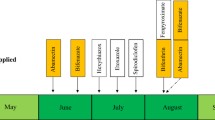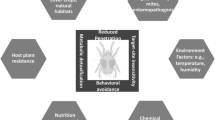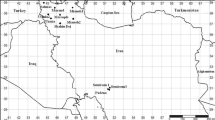Abstract
The polyphagous pest Tetranychus urticae feeds on over 1100 plant species including highly valued economic crops such as hops (Humulus lupulus). In the key hop production region of the Pacific Northwest of the USA, T. urticae is one of the major arthropod pests. Over the years, T. urticae control has been dominated by the application of various acaricides. However, T. urticae quickly adapts to these acaricides by developing resistance. Here, we determined resistance ratios of T. urticae populations in hops to three acaricides: etoxazole, fenpyroximate, and spirodiclofen. The mechanisms underlying resistance to these and three other acaricides were investigated in 37 field-collected T. urticae populations using a comprehensive diagnostic approach. Our data showed that T. urticae populations exhibited complex adaptation patterns to acaricides. Resistance to abamectin, fenpyroximate, and spirodiclofen by enhanced target metabolic detoxification gene(s) was identified in 100%, 50%, and 20% of populations tested, respectively. Resistance to bifenthrin, bifenazate, and etoxazole by target site insensitivity was pervasive among tested populations. Our study provides new information in understanding the complexity of T. urticae adaptation to multiple acaricides, which will help in designing sustainable pest control strategies for T. urticae on hops and other economically valuable crops.




Similar content being viewed by others
References
Abbott WS (1925) A method of computing the effectiveness of an insecticide. J Econ Entomol 18:265–267
Adesanya AW, Morales MA, Walsh DB, Lavine LC, Lavine MD, Zhu F (2018) Mechanisms of resistance to three mite growth inhibitors of Tetranychus urticae in hops. Bull Entomol Res 108:23–34
Bajda S, Dermauw W, Panteleri R, Sugimoto N, Douris V, Tirry L, Osakabe M, Vontas J, Van Leeuwen T (2017) A mutation in the PSST homologue of complex I (NADH:ubiquinone oxidoreductase) from Tetranychus urticae is associated with resistance to METI acaricides. Insect Biochem Mol Biol 80:79–90
Carletto J, Martin T, Vanlerberghe-Masutti F, Brevault T (2010) Insecticide resistance traits differ among and within host races in Aphis gossypii. Pest Manag Sci 66:301–307
Demaeght PA (2015). A genomic approach to investigate resistance mechanisms in the two-spotted spider mite Tetranychus urticae. Ph.D., University of Amsterdam
Demaeght P, Dermauw W, Tsakireli D, Khajehali J, Nauen R, Tirry L, Vontas J, Lummen P, Van Leeuwen T (2013) Molecular analysis of resistance to acaricidal spirocyclic tetronic acids in Tetranychus urticae: CYP392E10 metabolizes spirodiclofen, but not its corresponding enol. Insect Biochem Mol Biol 43:544–554
Demaeght P, Osborne EJ, Odman-Naresh J, Grbic M, Nauen R, Merzendorfer H, Clark RM, Van Leeuwen T (2014) High resolution genetic mapping uncovers chitin synthase-1 as the target-site of the structurally diverse mite growth inhibitors clofentezine, hexythiazox and etoxazole in Tetranychus urticae. Insect Biochem Mol Biol 51:52–61
Dermauw W, Ilias A, Riga M, Tsagkarakou A, Grbic M, Tirry C, Van Leeuwen T, Vontas J (2012) The cys-loop ligand-gated ion channel gene family of Tetranychus urticae: implications for acaricide toxicology and a novel mutation associated with abamectin resistance. Insect Biochem Mol Biol 42:455–465
Dermauw W, Wybouw N, Rombauts S, Menten B, Vontas J, Grbic M, Clark RM, Feyereisen R, Van Leeuwen T (2013) A link between host plant adaptation and pesticide resistance in the polyphagous spider mite Tetranychus urticae. Proc Natl Acad Sci USA 110:E113–E122
Feyereisen R (1995) Molecular biology of insecticide resistance. Toxicol Lett 82–83:83–90
Goodhue RE, Bolda M, Farnsworth D, Williams JC, Zalom FG (2011) Spotted wing drosophila infestation of California strawberries and raspberries: economic analysis of potential revenue losses and control costs. Pest Manag Sci 67:1396–1402
Grbic M, Van Leeuwen T, Clark RM, Rombauts S, Rouze P, Grbic V et al (2011) The genome of Tetranychus urticae reveals herbivorous pest adaptations. Nature 479:487–492
Hu Z, Du Y, Nomura Y, Dong K (2011) A sodium channel mutation identified in Aedes aegypti selectively reduces cockroach sodium channel sensitivity to type I, but not type II pyrethroids. Insect Biochem Mol Biol 41:9–13
Huggett J, Dheda K, Bustin S, Zumla A (2005) Real-time RT-PCR normalisation; strategies and considerations. Genes Immun 6:279–284
Ilias A, Vontas J, Tsagkarakou A (2014) Global distribution and origin of target site insecticide resistance mutations in Tetranychus urticae. Insect Biochem Mol Biol 48:17–28
Karatolos N, Williamson MS, Denholm I, Gorman K, Ffrench-Constant R, Nauen R (2012) Resistance to spiromesifen in Trialeurodes vaporariorum is associated with a single amino acid replacement in its target enzyme acetyl-coenzyme A carboxylase. Insect Mol Biol 21:327–334
Kasai S, Ng LC, Lam-Phua SG, Tang CS, Itokawa K, Komagata O, Kobayashi M, Tomita T (2011) First detection of a putative knockdown resistance gene in major mosquito vector, Aedes albopictus. Jpn J Infect Dis 64:217–221
Kawada H, Higa Y, Komagata O, Kasai S, Tomita T, Thi Yen N, Loan LL, Sanchez RA, Takagi M (2009) Widespread distribution of a newly found point mutation in voltage-gated sodium channel in pyrethroid-resistant Aedes aegypti populations in Vietnam. PLoS Negl Trop Dis 3:e527
Kim SS, Seo SG, Park JD, Kim SG, Kim DI (2005) Effects of selected pesticides on the predatory mite, Amblyseius cucumeris (Acari: Phytoseiidae). J Entomol Sci 40:107–114
Kwon DH, Clark JM, Lee SH (2010a) Cloning of a sodium channel gene and identification of mutations putatively associated with fenpropathrin resistance in Tetranychus urticae. Pest Biochem Physiol 97:93–100
Kwon DH, Yoon KS, Clark JM, Lee SH (2010b) A point mutation in a Glutamate-gated chloride channel confers abamectin resistance in the two-spotted spider mite, Tetranychus urticae Koch. Insect Mol Biol 19:583–591
Liu N, Yue X (2000) Insecticide resistance and cross-resistance in the house fly (Diptera: Muscidae). J Econ Entomol 93:1269–1275
Liu N, Zhu F, Xu Q, Pridgeon JW, Gao XW (2006) Behavioral change, physiological modification, and metabolic detoxification: mechanisms of insecticide resistance. Acta Entomol Sin 49:671–679
Lümmen P, Khajehali J, Luther K, Van Leeuwen T (2014) The cyclic keto-enol insecticide spirotetramat inhibits insect and spider mite acetyl-CoA carboxylases by interfering with the carboxyltransferase partial reaction. Insect Biochem Mol Biol 55:1–8
Mcmurtry JA, Croft BA (1997) Life-styles of Phytoseiid mites and their roles in biological control. Annu Rev Entomol 42:291–321
Morales MA, Mendoza BM, Lavine LC, Lavine MD, Walsh DB, Zhu F (2016) Selection of reference genes for expression studies of xenobiotic adaptation in Tetranychus urticae. Int J Biol Sci 12:1129–1139
Motoba K, Suzuki T, Uchida M (1992) Effect of a new acaricide, fenpyroximate, on energy metabolism and mitochondrial morphology in adult female Tetranychus urticae (two-spotted spider mite). Pest Biochem Physiol 43:37–44
Nauen R (2005) Spirodiclofen: mode of action and resistance risk assessment in tetranychid pest mites. J Pestic Sci 30:272–274
O’Neal SD, Walsh DB, Gent DH, Barbour JD, Boydston RA, George AE, James DG, Sirrine JR (2015) Field guide for integrated pest management in hops. U.S. Hop Industry Plant Protection Committee, Pullman, WA
Pavlidi N, Tseliou V, Riga M, Nauen R, Van Leeuwen T, Labrou NE, Vontas J (2015) Functional characterization of glutathione S-transferases associated with insecticide resistance in Tetranychus urticae. Pestic Biochem Physiol 121:53–60
Piraneo TG, Bull J, Morales MA, Lavine LC, Walsh DB, Zhu F (2015) Molecular mechanisms of Tetranychus urticae chemical adaptation in hop fields. Sci Rep 5:17090
Riga M, Tsakireli D, Ilias A, Morou E, Myridakis A, Stephanou EG, Nauen R, Dermauw W, Van Leeuwen T, Paine M, Vontas J (2014) Abamectin is metabolized by CYP392A16, a cytochrome P450 associated with high levels of acaricide resistance in Tetranychus urticae. Insect Biochem Mol Biol 46:43–53
Riga M, Myridakis A, Tsakireli D, Morou E, Stephanou EG, Nauen R, Van Leeuwen T, Douris V, Vontas J (2015) Functional characterization of the Tetranychus urticae CYP392A11, a cytochrome P450 that hydroxylates the METI acaricides cyenopyrafen and fenpyroximate. Insect Biochem Mol Biol 65:91–99
Soderlund DM, Knipple DC (2003) The molecular biology of knockdown resistance to pyrethroid insecticides. Insect Biochem Mol Biol 33:563–577
Stumpf N, Nauen R (2002) Biochemical markers linked to abametin resistance in Tetranychus urticae (Acari: Tetranychidae). Pest Biochem Physiol 72:111–121
Tsagkarakou A, Van Leeuwen T, Khajehali J, Ilias A, Grispou M, Williamson MS, Tirry L, Vontas J (2009) Identification of pyrethroid resistance associated mutations in the para sodium channel of the two-spotted spider mite Tetranychus urticae (Acari: Tetranychidae). Insect Mol Biol 18:583–593
Van Leeuwen T, Dermauw W (2016) The molecular evolution of xenobiotic metabolism and resistance in chelicerate mites. Annu Rev Entomol 61:475–498
Van Leeuwen T, Vanholme B, Van Pottelberge S, Van Nieuwenhuyse P, Nauen R, Tirry L, Denholm I (2008) Mitochondrial heteroplasmy and the evolution of insecticide resistance: non-Mendelian inheritance in action. Proc Natl Acad Sci USA 105:5980–5985
Van Leeuwen T, Vontas J, Tsagkarakou A, Tirry L (2009) Mechanisms of acaricide resistance in the two-spotted spider mite Tetranychus urticae. In: Ishaaya I, Horowitz A (eds) Biorational control of arthropod pests. Springer, Berlin
Van Leeuwen T, Vontas J, Tsagkarakou A, Dermauw W, Tirry L (2010) Acaricide resistance mechanisms in the two-spotted spider mite Tetranychus urticae and other important Acari: a review. Insect Biochem Mol Biol 40:563–572
Van Leeuwen T, Demaeght P, Osborne EJ, Dermauw W, Gohlke S, Nauen R, Grbic M, Tirry L, Merzendorfer H, Clark RM (2012) Population bulk segregant mapping uncovers resistance mutations and the mode of action of a chitin synthesis inhibitor in arthropods. Proc Natl Acad Sci USA 109:4407–4412
Van Leeuwen T, Dermauw W, Grbic M, Tirry L, Feyereisen R (2013) Spider mite control and resistance management: does a genome help? Pest Manag Sci 69:156–159
Van Leeuwen T, Tirry L, Yamamoto A, Nauen R, Dermauw W (2015) The economic importance of acaricides in the control of phytophagous mites and an update on recent acaricide mode of action research. Pestic Biochem Physiol 121:12–21
Van Nieuwenhuyse P, Van Leeuwen T, Khajehali J, Vanholme B, Tirry L (2009) Mutations in the mitochondrial cytochrome b of Tetranychus urticae Koch (Acari: Tetranychidae) confer cross-resistance between bifenazate and acequinocyl. Pest Manag Sci 65:404–412
Van Pottelberge S, Van Leeuwen T, Nauen R, Tirry L (2009) Resistance mechanisms to mitochondrial electron transport inhibitors in a field-collected strain of Tetranychus urticae Koch (Acari: Tetranychidae). Bull Entomol Res 99:23–31
Weston DP, Poynton HC, Wellborn GA, Lydy MJ, Blalock BJ, Sepulveda MS, Colbourne JK (2013) Multiple origins of pyrethroid insecticide resistance across the species complex of a nontarget aquatic crustacean, Hyalella azteca. Proc Natl Acad Sci USA 110:16532–16537
Zhu F, Gujar H, Gordon JR, Haynes KF, Potter MF, Palli SR (2013) Bed bugs evolved unique adaptive strategy to resist pyrethroid insecticides. Sci Rep 3:1456
Zhu F, Lavine L, O’neal S, Lavine M, Foss C, Walsh D (2016a) Insecticide resistance and management strategies in urban ecosystems. Insects. https://doi.org/10.3390/insects7010002
Zhu KY, Merzendorfer H, Zhang W, Zhang J, Muthukrishnan S (2016b) Biosynthesis, turnover, and functions of chitin in insects. Annu Rev Entomol 61:177–196
Acknowledgements
The authors thank Tora Brooks, Dan Groenendale, Peng Wilson, and members of the Agricultural Entomology lab of WSU IAREC at Prosser, WA, for their help with field mite collection. This research was funded by the United States Department of Agriculture National Institute of Food and Agriculture Specialty Crop Research Initiative (SCRI) (Award Number 2014-51181-22381), the Hop Research Council, the Washington Hop Commission, the Washington State Commission on Pesticide Registration. M.W. was supported by the Education Department of Fujian Province of China.
Author information
Authors and Affiliations
Corresponding author
Ethics declarations
Conflict of interest
The authors declare they have no conflicts of interest.
Ethical approval
This article does not contain any studies with human participants or animals performed by any of the authors.
Additional information
Communicated by Y. Gao.
Electronic supplementary material
Below is the link to the electronic supplementary material.
Rights and permissions
About this article
Cite this article
Wu, M., Adesanya, A.W., Morales, M.A. et al. Multiple acaricide resistance and underlying mechanisms in Tetranychus urticae on hops. J Pest Sci 92, 543–555 (2019). https://doi.org/10.1007/s10340-018-1050-5
Received:
Revised:
Accepted:
Published:
Issue Date:
DOI: https://doi.org/10.1007/s10340-018-1050-5




